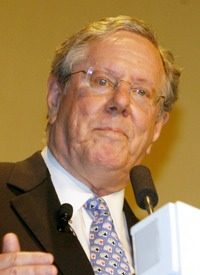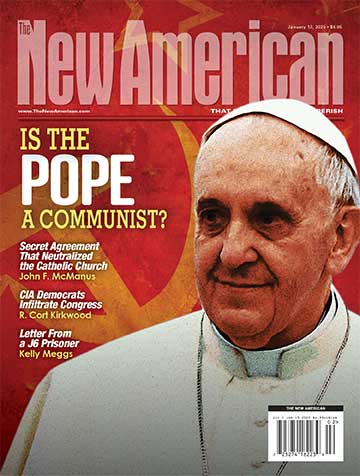
“People know that something is wrong with the dollar,” Forbes said in an exclusive interview with the magazine, laying the blame for the currency’s infirmity squarely on the Fed, which he said is like “a bull in a china shop” that “can’t help but knock things down.”
“You cannot trash your money without repercussions,” Forbes asserted. Those repercussions are all too familiar to Americans outside the financial and political elite: the still-deflating housing bubble, ever-rising prices for most other goods and services, increasing unemployment, and decreasing standards of living.
Then there’s the enormous and rapidly growing federal debt that threatens to bring our government and financial system to their knees — a debt that would not be possible without “the enabler of bad economic policy for many decades,” as Paul described the Fed in his opening remarks. He elaborated:
Until 1971 the United States operated on a gold exchange standard, meaning dollars could be redeemed in gold by foreign governments. [FDR had ended the domestic gold standard by executive order in 1933.] The dollar was thought to be “as good as gold” because the U.S. would never renege on its gold exchange commitment. The U.S. had to keep that commitment or risk gold outflows that presumably would keep the government from engaging in loose fiscal and monetary policy.
Unfortunately, the system did not in fact keep government spending in check. The federal government ran large budget deficits throughout the 1960s, with the Federal Reserve duly covering the gap and inflating the money supply. Foreign creditors understood that the dollar was being devalued, and increasingly began to exchange their dollars for gold. Rather than bring monetary and fiscal policies back into balance, however, the federal government under President Nixon defaulted on its obligations by closing the gold window in August of 1971.
The result: a national debt that now tops $14 trillion, with the Obama administration begging Congress to raise the debt ceiling by another $2 trillion or so, and rampant inflation such that the dollar has lost nearly 96 percent of its purchasing power since the Fed was created in 1913.
Because of this, Forbes believes the time is ripe for a revival of the “barbarous relic,” as economist John Maynard Keynes once called the gold standard, rightly viewing it as an impediment to his prescription for massive government spending accompanied by corresponding inflation and public debt. (Nixon, upon closing the gold window, declared, “I am now a Keynesian.”) Returning to the gold standard “would help to stabilize the value of the dollar, restore confidence among foreign investors in U.S. government bonds, and discourage reckless federal spending,” Forbes told Human Events. “The constantly changing value of the U.S. dollar leads to marketplace uncertainty and consequently spurs speculation in commodity investing as a hedge against inflation,” he added.
With a stable currency, it is “much harder” for governments to borrow excessively, Forbes said. Without lax Federal Reserve System monetary policies that led to the printing of too much money, the housing bubble would not have been nearly as severe, he added.
“When it comes to exchange rates and monetary policy, people often don’t grasp” what is at stake for the economy, Forbes said. By restoring the gold standard, the United States would shift away from “less responsible policies” and toward a stronger dollar and a stronger America, he said. “If the dollar was as good as gold, other countries would want to buy it.”
Human Events notes that Paul is the “only probable 2012 presidential candidate who has championed a return to the gold standard” but adds that Forbes thinks “the idea ‘makes too much sense’ not to gain popularity” in the current economic climate. Forbes is encouraged that other influential members of Congress, such as Rep. Paul Ryan (R-Wis.), are beginning to question the Fed’s policies as well.
Capitol Hill isn’t the only place where gold is beginning to get its turn in the limelight. Several states are considering measures to establish gold and silver coin as legal tender within their borders (South Carolina is the latest to do so), and Utah has already passed such legislation. South Carolina Rep. Mac Toole (R) explained why he supports his state’s bill: “I’m no financial expert but I am smart enough to know that you can’t keep printing money when it has no backing.” Americans seem to be waking up to that fact at long last, and Forbes can obviously read the mood of the country.
Getting onto a gold standard of some sort within five years, as Forbes predicted, is eminently possible. Paul has, for example, suggested legalizing currencies that could compete with Federal Reserve Notes — currencies that necessarily would be precious metals-based for them to gain acceptance — a move that could happen relatively quickly in a legislative sense, with the fast-moving free market taking over from there. States, as mentioned above, are already beginning to take matters into their own hands via legal tender laws. However, if such laws fail to make an alternative currency practical, they can always adopt the plan for “electronic gold or silver” outlined by Edwin Vieira, Jr., in a recent interview with The New American — a plan that Vieira says could be up and running “in approximately 60 to 90 days after the necessary statutes were enacted.”
Constitutionalists hope that the prognostication of Forbes comes to pass. They understand that tying the currency to precious metals is the surest way to prevent runaway federal spending, debt, and inflation. In the words of Ron Paul, “If we have learned anything from history, we should know that printing money out of thin air cannot lead to prosperity. It can only lead to penury.”
Photo of Steve Forbes: AP Images



